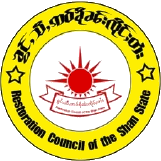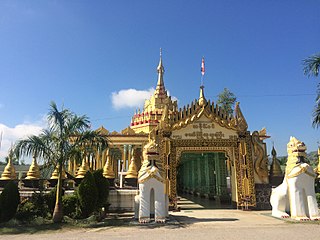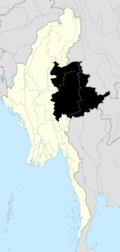
The Shan State Army - South, also known simply as the Shan State Army, is the armed wing of the Restoration Council of Shan State (RCSS) and one of the largest insurgent groups in Myanmar (Burma). The SSA-S was led by Lieutenant General Yawd Serk until his resignation on 3 February 2014. Yawd Serk was reelected chairman of the RCSS shortly after his resignation and has remained chairman since.

Lawksawk Township is a township of Taunggyi District in the Shan State of Myanmar. The principal town is Lawksawk.

Kyaukme District is a district of northern Shan State in Burma (Myanmar). As of 2001, it consisted of 9 towns and 1946 villages.

Nawnghkio, variously spelt Naunghkio, Naungcho or Nawngcho, is a town in Kyaukme District, in northern Shan State, Burma. It is the principal town and administrative seat of Nawnghkio Township. It is connected to Mandalay, Pyin U Lwin, Kyaukme, Hsipaw and Lashio by road and rail and by road to Taunggyi via National Road 43. Asia World Company won the contract to rebuild part of the road in 2002. Originally on the Mandalay-Lashio Road, after Pyin U Lwin and before Kyaukme, Nawnghkio is on what is now the Mandalay-Muse Road, part of the Asian Highway Route 14 (AH14).

Kyaukme is a town in northern Shan State of Burma. It is situated on the Mandalay - Lashio road, after Pyin Oo Lwin and Nawnghkio, and before Hsipaw, on what is now the Mandalay - Muse road, part of the Asian Highway route 14 (AH14). It is also connected to Momeik (Mongmit) in the Shweli River valley and Mogok with its ruby mines. Kyaukme can be reached by train on the Mandalay-Lashio railway line.

Momeik, also known as Mong Mit in Shan, is a town situated on the Shweli River in northern Shan State of Myanmar (Burma).
Shwenankyawshin Narapati was king of Ava from 1501 to 1527. His reign saw the disintegration of the Ava Kingdom. He spent much of his reign fighting back the attacks from the Confederation of Shan States. But his efforts ultimately proved unsuccessful. The king died fighting while defending his capital from Confederation attacks, after which Ava Kingdom was taken over by the Confederation.
Mobye Narapati was the penultimate king of Ava who reigned from 1545 to 1551. The ethnically Shan king ruled as the disputed leader of the Confederation of Shan states that had ruled Ava since 1527. He ended the seven years' war with Toungoo as soon as he came to power. Throughout his six years of reign, he faced an active rebellion by Sithu Kyawhtin, who was supported by the Shan state of Mohnyin. He controlled only a rump state, east of the Irrawaddy and north of Pagan (Bagan). After he was finally driven out of Ava (Inwa) in October 1551, he fled south to Pegu (Bago) where he was given protection by King Bayinnaung of Toungoo Dynasty. He lived out his years at Pegu.
Thohanbwa was king of Ava from 1527 to 1542. The eldest son of Sawlon of Mohnyin was a commander who actively participated in Monhyin's numerous raids of Ava's territories in the first quarter of 16th century. In March 1527, the ethnically Shan king was appointed king of Ava by Sawlon after Mohnyin-led confederation of Shan States defeated Ava in 1527. After Sawlon was assassinated in 1533, Thohanbwa became the undisputed king of Ava as well as chief of Mohnyin. However, he was not immediately accepted by other chiefs as the leader of the confederation.
Hkonmaing was king of Ava from 1542 to 1545. The saopha of the Shan state of Onbaung–Hsipaw was elected by the Ava court to the Ava throne in 1542, by extension the leader of the Confederation of Shan States, despite strenuous objections by the House of Mohnyin. He was accepted as the leader by other Confederation leaders only because the Confederation was in the middle of a serious war with Toungoo Dynasty. After the Confederation's failed military campaigns in 1543–45 that resulted in the loss of Central Burma, Hkonmaing lost the support of Sawlon II of Mohnyin. He died in 1545 while fighting a Mohnyin-backed rebellion by Sithu Kyawhtin.

Hsipaw, also known as Thibaw, is the principal town of Hsipaw Township in Shan State, Myanmar on the banks of the Duthawadi River. It is 200 kilometres (120 mi) north-east of Mandalay.
Hsipaw Yazawin or Thibaw Yazawin is a 19th-century Burmese chronicle that covers the history of the Shan state of Hsipaw (Thibaw). It is believed to have been written after the publication of Hmannan Yazawin.
Hkonmaing was saopha of the Shan principality of Onbaung–Hsipaw in what is now Myanmar. He was the only main ally of King Narapati II of Ava in the latter's 25-year struggle against the Mohnyin-led Confederation of Shan States, Prome and Toungoo. After Ava's fall, he became a member of the Confederation. He died during or shortly after his participation in the Confederation's 1542 campaign against Toungoo Dynasty. His son, also named Hkonmaing, and grandson Narapati III became kings of Ava.

Hsipaw, also known as Thibaw was a Shan state in what is today Myanmar. Its capital was Hsipaw town. Hsipaw State was perhaps one of the most well known and powerful Shan States.

Mongmit or Möngmit, also known as Momeik, was a Shan state in the Northern Shan States in what is today Burma. The capital was Mongmit town. The state included the townships of Mongmit and Kodaung.

The Shan State Army-North, also known as Shan State Army/Special Region 3 (SSA/SR-3) is a Shan nationalist insurgent group in Myanmar (Burma). It is the armed wing of the Shan State Progress Party (SSPP).

The Restoration Council of Shan State is a Shan political organisation in Shan State, Myanmar, founded in 1996 by Shan military leader Yawd Serk. Its armed wing, the Shan State Army - South (SSA-S).
The Nationwide Ceasefire Agreement was a landmark ceasefire agreement between the government of Myanmar and representatives of various ethnic insurgent groups, officially known as "ethnic armed organisations" (EAOs) by the government. The draft was agreed upon by a majority of the invited parties on 31 March 2015, and the agreement was signed by President Thein Sein on 15 October 2015. The signing was witnessed by observers and delegates from the United Nations, the United Kingdom, Norway, Japan and the United States. A ceremony is held by the government annually on the anniversary of the signing of the agreement.
Sai Thant Zin is a Burmese politician who currently serves as a Pyithu Hluttaw member of parliament for the Hsipaw constituency. He is a member of the Shan Nationalities League for Democracy.

The Bawgyo Pagoda is a Buddhist temple in Hsipaw, Myanmar. Built in the 12th century, the temple is located in Bawgyo village, several miles from the town of Hsipaw. Every march, the temple is the site of a Buddhist festival that commemorates the pagoda's founding.












